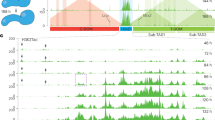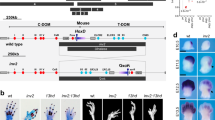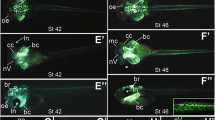Abstract
INVOLVEMENT of the Hox genes in regional specifications of the vertebrate body axis is suggested by sequence similarity with the homeotic selector genes of Drosophila, the conservation of a collinear relationship between genomic organization and site of expression, and mutational analysis1–5. Subdivision of vertebrate embryo hindbrain neuroepithelium into lineage compartments6 (rhombomeres7,8) underlies segmental patterning of neuronal differentiation9. The rhombomere boundaries delimit domains of expression of Hox genes10–12, presumed to be determinants of rhombomere phenotype, suggesting that Hox genes confer positional value13; the formation of rhombomere 4 (r4) is followed by strong expression of Hox-2.9within its confines14. If the Hox genes are determinants, their expression should be autonomous from the developmental stage at which regional commitment becomes fixed and irreversible. We have transplanted the future r4 region (from state-9 – chick embryos) into the more anterior position of r2 and probed for Hox-2.9 transcripts. We report here that Hox-2.9 was expressed in the ectopic r4 as strongly as in the normal r4, whereas reciprocal grafts of future r2 to r4 position did not express Hox-2.9. The phenotype of ectopic rhombomeres developed according to their original position, as demonstrated by retrograde tracing of efferent cranial nerve nuclei. As early as stage-9 – (six somites), both Hox-2.9 expression and segment identity are autonomous in the chick embryo hindbrain, independent both of position in the neuroepithelium and of signals from the underlying mesoderm15.
This is a preview of subscription content, access via your institution
Access options
Subscribe to this journal
Receive 51 print issues and online access
$199.00 per year
only $3.90 per issue
Buy this article
- Purchase on Springer Link
- Instant access to full article PDF
Prices may be subject to local taxes which are calculated during checkout
Similar content being viewed by others
References
Graham, A., Papalopulu, N. & Krumlauf, R. Cell 57, 367–378 (1989).
Duboule, D. & Dolle, P. EMBO J. 8, 1497–1505 (1989).
Lewis, E. B. Nature 276, 565–570 (1978).
Harding, K. et al. Science 229, 1236–1242 (1985).
Akam, M. Cell 57, 347–349 (1989).
Fraser, S., Keynes, R. & Lumsden, A. Nature 344, 431–435 (1990).
Gräper, L. Arch, mikrosk. Anat Entw Mech. 83, 371–426 (1913).
Lumsden, A. Trends Neurosci. 13, 329–335 (1990).
Lumsden, A. & Keynes, R. Nature 337, 424–428 (1989).
Gaunt, S. J. Development 101, 51–60 (1987).
Murphy, P., Davidson, D. R. & Hill, R. E. Nature 341, 156–159 (1989).
Wilkinson, D. G. et al. Nature 341, 405–409 (1989).
Hunt, P. et al. Nature 353, 861–864 (1991).
Sundin, O. H. & Eichele, G. Genes Dev. 4, 1267–1276 (1990).
Frohmann, M., Boyle, M. & Martin, G. Development 110, 589–608 (1990).
Maden, M. et al. Development 111, 35–44 (1991).
Hamburger, V. & Hamilton, H. J. Morph. 88, 49–92 (1951).
Mangold, O. Naturwissenschaften 21, 761–766 (1933).
Holtfreter, J. Wilhelm Roux Arch. Entw Mech. Org. 134, 446–550 (1936).
Hemmati-Brivanlou, A., Stewart, R. M. & Harland, R. M. Science 250, 800–802 (1990).
Sharp, C. R. & Gurdon, J. B. Development 109, 765–774 (1990).
Ruiz i Altaba, A. Development 108, 595–604 (1990).
Murphy, P. & Hill, R. E. Development 111, 61–74 (1991).
Lufkin, T. et al. Cell 66, 1105–1119 (1991).
Chisaka, O., Musci, T. S. & Capecchi, M. R. Nature 355, 516–520 (1992).
Wilkinson, D. & Green, J. in Postimplantation Mouse Embryos, a Practical Approach (eds Rickwood, D. & Cockcroft, D. L.) 155–171 (IRL, Oxford 1990).
Whiting, J. et al. Genes Dev. 5, 2048–2059 (1991).
Author information
Authors and Affiliations
Rights and permissions
About this article
Cite this article
Guthrie, S., Muchamore, I., Kuroiwa, A. et al. Neuroectodermal autonomy of Hox-2.9 expression revealed by rhombomere transpositions. Nature 356, 157–159 (1992). https://doi.org/10.1038/356157a0
Received:
Accepted:
Issue Date:
DOI: https://doi.org/10.1038/356157a0
This article is cited by
-
PIASxβ acts as an activator of Hoxb1 and is antagonized by Krox20 during hindbrain segmentation
The EMBO Journal (2006)
-
Evolutionary developmental biology and vertebrate head segmentation: A perspective from developmental constraint
Theory in Biosciences (2003)
-
Plasticity in mouse neural crest cells reveals a new patterning role for cranial mesoderm
Nature Cell Biology (2000)
-
Patterning the cranial neural crest: Hinbrain segmentation and hox gene plasticity
Nature Reviews Neuroscience (2000)
-
Getting there and being there in the cerebral cortex
Experientia (1995)
Comments
By submitting a comment you agree to abide by our Terms and Community Guidelines. If you find something abusive or that does not comply with our terms or guidelines please flag it as inappropriate.



